#opisthothelae
Text
Pau pequeno gostoso
tetona morenaza follando con madura madrasta
INDIAN DESI GIRLS MASTURBATING CAMSHOW
MYLF - Smoking Hot Artistic Milf With Big Titties Seduces Her Nude Painting Male Model
Amazing solo girl boasts of her wonderful tits and pink pussy
BELLA THORNE HOT JERK OFF CHALLENGE SESSION
Reality Kings - PAWG Abigail Mac & Ella Knox have fun with selfie stick
Indian Boyfriend sucks gf juicy pussy lips
Tattooed pornstar pov jerking and cocksucking
Hot young teen girl Cadey fuck her pink bald pussy with glass dildo deep
#lyso-#appa#unwatchable#evilly#dockyardman#decoration#Opisthothelae#eudaemonistic#relocked#overalls#enactable#zingaresca#ancestor's#gustoso#splanchnicectomies#crazy-headed#antiuating#Persepolitan#rheen#canalling
1 note
·
View note
Text
A (Very) Brief Overview of The Spider Tree of Life

Let's start with the basics. All spiders fall into the following classification, from least to most specific:
Kingdom: Animalia (animals - cannot produce their own food, can move voluntarily, and are multicellular)
Phylum: Arthropoda (animals with jointed exoskeletons made of chitin)
Subphylum: Chelicerata (chelicerates - possess feeding appendages called chelicerae)
Class: Arachnida (arachnids - eight legs with an additional pair of appendages, fused head and thorax, and several more unique traits)
Order: Araneae (spiders - chelicerates that possess spinnerets for silk production, and have special male copulatory organs that we'll get into some other time)
Okay, so we've reached the clade that includes all spiders: Araneae. This is the order level. Just below order, spiders have a level called the suborder ("sub" meaning "under"). Here, spiders split into two suborders: Mesothelae and Opisthothelae.
Mesothelae is an incredible group of spiders with only a few extant (non-extinct) taxa. The defining characteristic of its members is an abdomen that's segmented by plates called tergites. This is a trait that was also present in the ancestors of spiders, so we may consider the Mesothelae to be "primitive" since they possess ancestral traits. All other spiders (the Opisthothelae) have abdomens that are fused into a single unit, which is the derived (non-ancestral) trait.

Heptathela higoensis, a member of the suborder Mesothelae. Photo by Marshal Hedin
Okay, so now we know the two suborders of spiders: Mesothelae (the "primitive" segmented spiders) and Opisthothelae (the non-segmented spiders). But we're not done yet! Opisthothelae divides into two infraorders ("infra" meaning "below" or "further on"). These infraorders are Mygalomorphae and Araneomorphae.
Mygalomorphae shares some common features with the Mesothelae - namely downward-facing chelicerae (mouthparts) and two pairs of book lungs (meaning four total). The araneomorphs, however, lack these ancestral features, instead sporting chelicerae that move in from the sides (causing the fangs to appear horizontal or "cross-acting") and fewer book lungs (only one pair or even zero!). Most araneomorphs also have tracheal systems, not unlike insects and myriapods (though the spider tracheal system evolved independently!).


Left: Atrax robustus, a mygalomorph with downward-facing chelicerae (photo by Tirin). Right: Cheiracanthium punctorium, an araneomorph with cross-acting chelicerae (photo by Rainer Altenkamp).
Finally, within the infraorders Mygalomorphae and Araneomorphae exist a myriad of diverse spider families. Araneomorphae is by far the more speciose and diverse of the two, but they both have their own unique charms. As of April 2023, there are a whopping 132 spider families recognized!
Follow for future posts about the many different families of spiders!
Information sources can be found below:
Coddington, Jonathan A. & Levi, Herbert W. (1991). "Systematics and evolution of spiders (Araneae)". Annual Review of Ecology and Systematics. 22: 565–592. doi:10.1146/annurev.es.22.110191.003025. JSTOR 2097274. S2CID 55647804.
Scientific name: Opisthothelae in Brands, S.J. (comp.) 1989-present. The Taxonomicon. Universal Taxonomic Services, Zwaag, The Netherlands. http://taxonomicon.taxonomy.nl/. Access date: 8 December 2010
Song, D.X.; Zhu, M.S. & Chen, J. (1999). The Spiders of China. Shijiazhuang, CN: Hebei University of Science and Technology Publishing House. ISBN 978-7-5375-1892-5.
Wheeler, W. C., Coddington, J. A., Crowley, L. M., Dimitrov, D., Goloboff, P. A., Griswold, C. E., … Zhang, J. (2016). The spider tree of life: phylogeny of Araneae based on target-gene analyses from an extensive taxon sampling. Cladistics, 33(6), 574–616. doi:10.1111/cla.12182
World Spider Catalog, 2023. Natural History Museum Bern. http://wsc.nmbe.ch, version 24.0 [accessed 30 April 2023].
#spiderblr#spiders#science#biology#taxonomy#zoology#arachnology#entomology#wildlife#animals#Araneae#bugblr#arthropods
7 notes
·
View notes
Photo
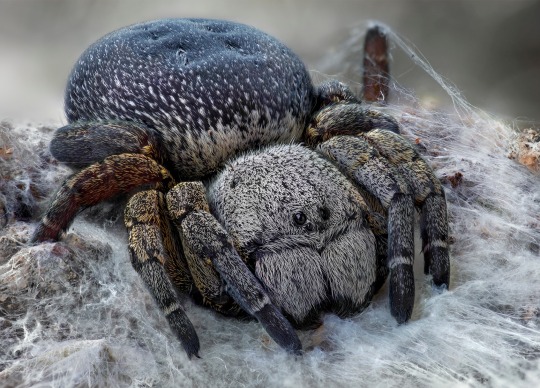
Ladybird spider (Eresus kollari)
Photo by Armen Seropian
#ladybird spider#velvet spider#eresus kollari#eresus#eresidae#entelegynae#araneoclada#opisthothelae#araneomorphae#aranae#arachnida#euchelicerata#chelicerata#arthropoda#ecdysozoa
9K notes
·
View notes
Photo

_Tetragnatha squamata_ #Tetragnatha #Arachnida #Araneae #Opisthothelae #Araneomorphae #Neocribellatae #Entelegynae #Araneoidea green big-jawed #spider nympha#ウロコアシナガグモ 幼体 _Cerasus × yedoensis ‘Somei-yoshino’_ #someiyoshino #floweringcherry #sakura #ソメイヨシノ (総社二子山古墳) https://www.instagram.com/p/BwQnTVOAmN9/?utm_source=ig_tumblr_share&igshid=1fnpg1w5wtz3z
#tetragnatha#arachnida#araneae#opisthothelae#araneomorphae#neocribellatae#entelegynae#araneoidea#spider#ウロコアシナガグモ#someiyoshino#floweringcherry#sakura#ソメイヨシノ
0 notes
Text
Rosamygale grauvogeli
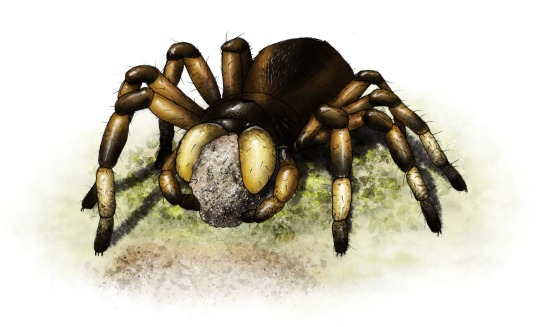
By Blaire Fei and Tas Dixon
Etymology: Grauvogel’s Rose bird-eating spider
First Described By: Selden and Gall, 1992
Classification: Biota, Archaea, Proteoarchaeota, Asgardarchaeota, Eukaryota, Neokaryota, Scotokaryota, Opimoda, Podiata, Amorphea, Obazoa, Opisthokonta, Holozoa, Filozoa, Choanozoa, Animalia, Arthropoda, Chelicerata, Arachnida, Araneae, Opisthothelae, Mygalomorphae, Hexathelidae, Rosamygale grauvogeli
Time and Place: Anisian age of the Lower Triassic, in France.
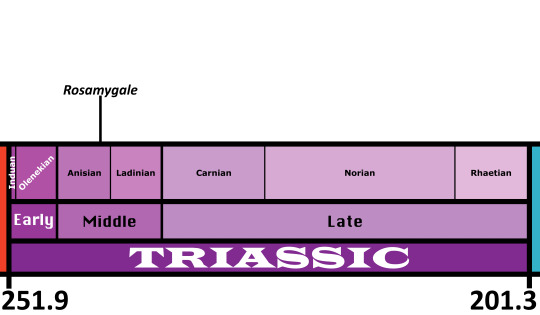
Rosamygale is known from the Anisian Triassic Grès à Voltzia formation in The Vosges, France

Physical Description: Rosamygale was a small mygalomorph spider that may have only reached a centimeter in size in life (the largest specimen has a 6.8mm-long body). Mygalomorph spiders have up-and-down moving fangs like tarantulas, as opposed to pinching fangs that move toward each other, with thick bristles right above the fangs on the chelicerae. Rosamygale had eight small eyes in two curved rows on a raised lobe on top of its head. Its legs reached two-thirds the length of the body, with shorter pedipalps. They had three tarsal claws with no claw tufts. Rosamygale was covered in small thick hairs, likely used for vibration detection underground as well as for protection against sharp dirt particles. Rosamygale had six spinnerets that extruded webbing, like most spiders.
Diet: Rosamygale was an ambush predator of invertebrates slightly smaller than its own size. During this time, very small scorpions, millipedes, and insects would have been its main diet. As it was found fairly close to the sealine, Rosamygale may have also eaten larval stages of various crustaceans that lived in the swamp it inhabited.
Behavior: As a fossorial spider, Rosamygale would have dug a deep burrow in soft but sturdy dirt and mud. Instead of actively hunting for its food, Rosamygale waited inside of this burrow, lined with silk, until a prey-sized animal walked along some of the silk outside. Then, Rosamygale would snatch the animal into the burrow to be eaten.
Female mygalomorph spiders can live for upwards of 20 years at a time, and many live a vast majority of their lives in the same geographic location once they establish their burrows. Like many mygalomorphs, Rosamygale likely only left their burrows as males seeking out mates during the end of the rainy season, as young spiderlings to move away from mom, or in emergency situations like burrow flooding or evading predators.
Ecosystem: Rosamygale lived in swamps along the margin of the Zechstein Sea in the Middle Triassic of France. This sea was hypersaline during this time period, and the climate was semi-arid and populated with various horsetails, ferns, and gymnosperms, with wet and dry seasons. The beds that Rosamygale was found in was predominantly clay and very close to a delta from the land leading to the ocean.
Other: Unlike other hexathelid spiders, Rosamygale appears to lack abdominal schlerae possibly due to its small size. Its Latin name is in honor of the fossil collector, Luis Grauvogel, and also a reference to the pink hue of the abdomen mineral infill. Despite mygale meaning “bird eater”, Rosamygale decidedly did not eat any birds.
--By Blaire Fei
Sources Under the Cut
P. A. Selden and J. Gall. 1992. A Triassic mygalomorph spider from the northern Vosges, France. Palaeontology 35(1):211-235
P. Selden. 2004. Evolution of Fossil Ecosystems, Ch. 10, pg. 125-128
#rosamygale#spider#triassic#triassic madness#triassic march madness#arachnophobia tw#prehistoric life#paleontology
106 notes
·
View notes
Photo
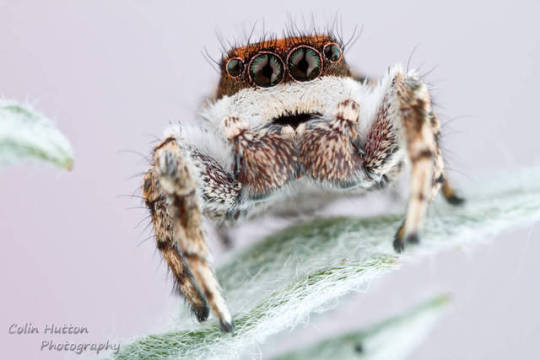
Habronattus conjunctus by ColinHuttonPhoto
#Animal#Arthropod#Spider#Jumping Spider#Invertebrate#Ecdysozoa#Arachnomorpha#Chelicerata#Arachnid#Araneae#Opisthothelae#Araneomorphae#Salticidae#Salticinae#Habronattus#Habronattus conjunctus
0 notes
Text
Spider (Araneae) Insect Animal 4K Video
Spider (Araneae) Insect Animal 4K Video Spider Scientific Name: Araneae Spider Kingdom: Animalia Spider Phylum: Arthropoda Spider Subphylum: Chelicerata Spider Class: Arachnida Spider Order: Araneae Spider Suborders: Mesothelae, Opisthothelae #spider #araneae #insect
Watch video on YouTube: https://youtu.be/mEMCXzktP20
1 note
·
View note
Text
Ok so I’m furious bc I’ve discovered that Tarantulas’ name is a fucking pun
Mesothelae is a suborder of spiders
Tarantulas are part of the Opisthothelae suborder but still
This is like Remus Lupin in robot form
#tw spiders#mesothulas#ignore this#im!! furious!!!!#nick roche im on to your game#and yes!! i did check the wiki for this and it did say but im angry so im making this anyway
32 notes
·
View notes
Text

Banded garden spider (Argiope trifasciata)
Photo by Adrián R. Simoni
#banded garden spider#argiope trifasciata#argiope#araneidae#araneoidea#entelegynae#araneomorphae#opisthothelae#araneae#arachnida#euchelicerata#chelicerata#arthropoda#panarthropoda#ecdysozoa
33 notes
·
View notes
Photo

Four-spotted orb weaver (Araneus quadratus)
Photo by John Hallmén
#four spotted orb weaver#orb weaver#araneus quadratus#araneus#araneini#araneidae#araneoidea#entelegynae#araneomorphae#opisthothelae#araneae#arachnida#euchelicerata#chelicerata#arthropoda#panarthropoda#ecdysozoa
186 notes
·
View notes
Photo
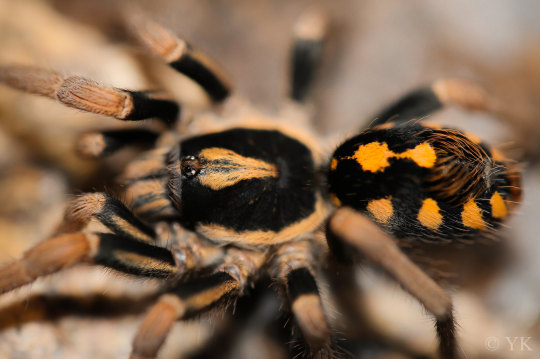
Lemon patch tarantula (Hapalopus triseriatus)
Photo by Yvonne Spidergirl
#fave#lemon patch tarantula#pumpkin patch tarantula#hapalopus triseriatus#hapalopus#theraphosinae#theraphosidae#avicularioidea#mygalomorphae#opisthothelae#araneae#arachnida#euchelicerata#chelicerata#arthropoda#panarthropoda#ecdysozoa#captive animal
101 notes
·
View notes
Photo

Peacock spider (Maratus sceletus)
Photo by Jurgen Otto
#peacock spider#maratus sceletus#maratus#euophryinae#salticoida#salticidae#dionycha#RTA clade#entelegynae#araneoclada#araneomorphae#opisthothelae#araneae#arachnida#euchelicerata#chelicerata#arthropoda#panarthropoda#ecdysozoa
120 notes
·
View notes
Photo

Wolf spider (Hoggicosa natashae)
Photo by Mark Newton
#fave#wolf spider#hoggicosa natashae#hoggicosa#lycosidae#lycosoidea#entelegynae#araneomorphae#opisthothelae#araneae#arachnida#euchelicerata#chelicerata#arthropoda#panarthropoda#ecdysozoa
54 notes
·
View notes
Photo

Caribbean diamond tarantula (Tapinauchenius violaceus)
Photo by Tom Patterson
#captive animal#caribbean diamond tarantula#tarantula#tapinauchenius violaceus#tapinauchenius#aviculariinae#theraphosidae#avicularioidea#mygalomorphae#opisthothelae#araneae#arachnida#euchelicerata#chelicerata#arthropoda#panarthropoda#ecdysozoa
29 notes
·
View notes
Photo

Gooty sapphire ornamental tarantula (Poecilotheria metallica)
Photo by Wildlife GmbH
#captive animal#gooty sapphire ornamental tarantula#ornamental tarantula#tarantula#poecilotheria metallica#poecilotheria#poecilotheriinae#theraphosidae#avicularioidea#mygalomorphae#opisthothelae#araneae#arachnida#euchelicerata#chelicerata#arthropoda#panarthropoda#ecdysozoa
39 notes
·
View notes
Photo

Trinidad dwarf tarantula (Cyriocosmus elegans)
Photo by Tunedbeat
#captive animal#trinidad dwarf tarantula#dwarf tarantula#tarantula#cyriocosmus elegans#cyriocosmus#theraphosinae#theraphosidae#avicularioidea#mygalomorphae#opisthothelae#araneae#arachnida#euchelicerata#chelicerata#arthropoda#panarthropoda#ecdysozoa
41 notes
·
View notes